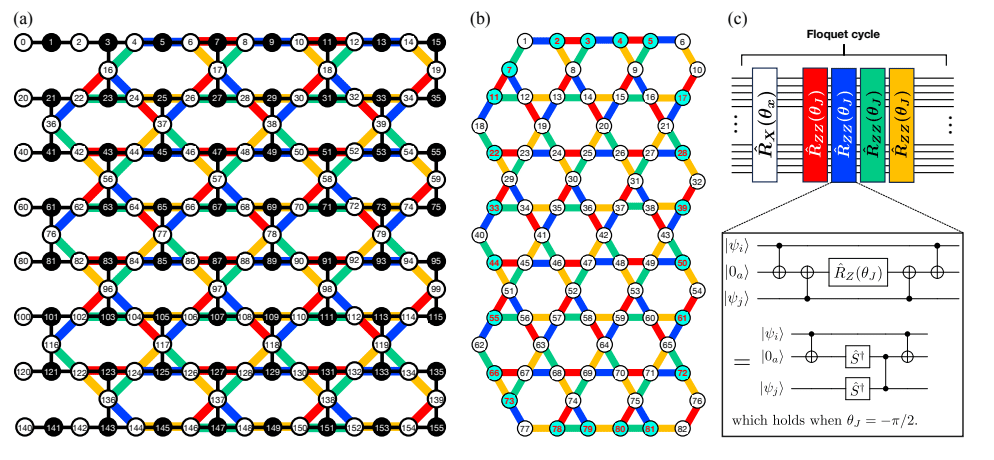The quest to understand how periodically driven quantum systems evolve has led researchers to investigate the emergence of discrete time crystals, phases of matter exhibiting persistent, predictable oscillations without consuming energy. Kazuya Shinjo, Kazuhiro Seki, and Seiji Yunoki, from the RIKEN Center for Emergent Matter Science and RIKEN Center for Quantum Computing, now demonstrate how quantum noise, inherent in digital quantum computers, unexpectedly influences the formation of these exotic states. Their work explores the relaxation dynamics of these systems, implemented on IBM Quantum processors, revealing two distinct mechanisms by which noise can either stabilize or suppress the emergence of time crystals. This research establishes that quantum noise in supporting ‘ancilla’ qubits doesn’t simply disrupt quantum behaviour, but can actively give rise to novel dynamical phases, including time crystals protected by system boundaries and those directly induced by noise itself, offering new avenues for controlling and observing these fascinating quantum phenomena.
Driven Systems, Many-Body Localization, and Topology
This collection of research papers focuses on the fascinating interplay between periodically driven quantum systems, many-body localization, quantum thermalization, and topological phases of matter. The studies explore how these concepts connect and influence each other, offering insights into the behavior of complex quantum materials. A central theme is the investigation of systems driven periodically in time, examining the unique properties that emerge under these conditions, including the potential for novel topological phases. Researchers also explore how quantum systems reach thermal equilibrium, or fail to do so, and the role of interactions and disorder in this process.
A significant portion of the research focuses on quantum information scrambling, the spreading of information within a system, and its connection to classical chaos. The studies also investigate topological phases of matter, characterized by robust edge states and non-trivial bulk properties, with a particular emphasis on those emerging from time-periodic driving. These studies suggest several promising research directions, including investigating how periodic driving affects the stability of many-body localized phases and exploring the interplay between Floquet topological phases and quantum information scrambling.
Discrete Time Crystals on Kagome and Lieb Lattices
Scientists have achieved the realization of novel dynamical phases, including noise-induced and boundary-protected discrete time crystals, on two-dimensional Kagome and Lieb lattices using IBM Quantum Eagle and Heron processors. The team embedded these lattices onto the processors by utilizing qubits as ancillas and then applied periodic transverse-field driving to an initial product state within a kicked Ising model. Measurements of local magnetization revealed subharmonic responses, indicating the presence of discrete time crystal behavior, with distinct characteristics arising from the interplay of lattice geometry and quantum noise. On the 53-qubit Kagome lattices implemented on the Eagle device, both type-I and type-II discrete time crystals were observed.
Experiments demonstrated that type-I crystals originated from robust boundary-mode oscillations, stabilized by symmetry charge pumping, which redistributed into the bulk due to noise in the ancilla qubits. In contrast, on the lower-noise Heron device, period-doubling oscillations were confined to boundary-localized oscillations on 82-qubit Kagome and 40-qubit Lieb lattices, as the suppression of bulk redistribution indicated a more stable system. Further analysis revealed that type-II discrete time crystals emerged in systems without charge-pumped qubits, where quantum noise unexpectedly stabilized period-doubling oscillations. Noisy matrix-product-state simulations, modeling ancilla noise as random sign flips, aligned with experimental results and demonstrate that quantum noise in ancilla qubits can give rise to novel prethermal dynamical phases.
Noise Stabilizes Discrete Time Crystals
Researchers have demonstrated the emergence of novel dynamical phases, including discrete time crystals, within periodically driven quantum systems implemented on IBM quantum processors. By constructing Kagome and Lieb lattices using ancillary qubits, the team investigated the relaxation dynamics of driven product states, revealing two distinct types of noise-induced discrete time crystals. Type-I crystals arise from symmetry-protected oscillations redistributed throughout the system due to noise in the ancillary qubits, while Type-II crystals emerge even without this symmetry, where quantum noise unexpectedly stabilizes oscillations. Experiments conducted on devices with varying levels of noise show that moderate levels of noise impede quantum information scrambling and promote the stabilization of these time-crystal phases. Supporting these experimental findings, noisy matrix-product-state simulations accurately reproduced the observed behavior by modeling the effects of noise in the ancillary qubits. These results demonstrate that quantum noise, when carefully considered, can give rise to previously unobserved dynamical phases and expand the possibilities for exploring complex quantum phenomena on near-term quantum hardware.
👉 More information
🗞 Emergent Discrete Time Crystals on Digital Quantum Computers: Boundary-Protected and Ancilla-Induced Disorder Mechanisms of Thermalization Slowdown
🧠 ArXiv: https://arxiv.org/abs/2510.13577

